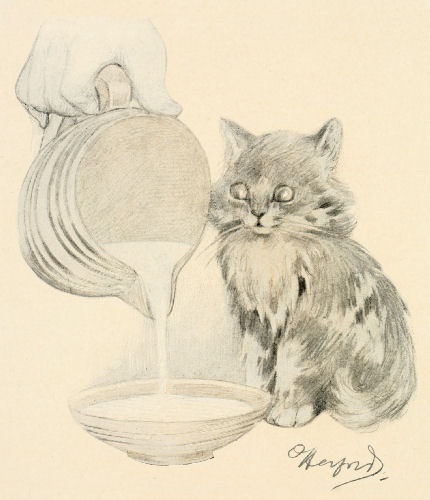
The Thammasat University Libraries have newly acquired Milk is Life, a history and appreciation of dairy farming. Its author, Sofia French, describes ancient traditions, such as in Southwest Asia from 9000 to 7000 BC, when people first began to consume the milk of other mammals. Dairy animals such as cows, sheep, and goats were also first tamed in Southwest Asia. Some archaeologists claim that animals were kept by ancient man to be eaten. Only much later was it discovered that dairy products were useful additions to the human diet. Thousands of years ago, milk was not just a beverage, it was also used as a kind of medicine. The ancient Egyptians used milk as part of treatment for burns. In East and Southeast Asia, for many years milk and dairy products were not an important part of people’s diet, mainly because most people did not own their own dairy animals. So milk began to be consumed in the ASEAN countries after European colonialism began in the past 500 years.
The Thai dairy industry.
The TU Libraries own a number of analyses of dairy farming in Thailand. The adventure began over 80 years ago, but large-scale dairy projects really started in the 1960s. At that time, the Thai Danish Farm and Training Centre (TDDF) was founded at Muak Lek by the Thai and Danish governments. In 1971, the Thai Government took over full directorship of this complex, which was renamed The Dairy Farming Promotion Organisation of Thailand (D.P.O.) part of the Ministry of Agriculture and Cooperatives. The D.P.O. promotes milk production, processes milk and encourages the sale of milk products. It offers reasonably priced cows to beginning farmers, trains farmers who want to try producing dairy products, and provides many other essential services and concrete help to the industry. At around the same time that milk was produced in Muak Lek, the Nong Pho area also became an important center for dairy farming. There smaller farmers were helped by the Department of Livestock Development (D.L.D.) and in 1971, a cooperative dairy plant was constructed. The Thai-German Dairy Training and Processing Plant in Chiang Mai was founded in 1968 and in 1977 its directorship was taken by the D.L.D. In the early 1980s, the D.P.O. started the dairy farming projects in the South, including a dairy plant in Pranburi, Prachuab Kirikan. It was found that too many farmers in the region were trying to grow pineapples, which were not selling well enough.

In 1962 The Thai Dairy Industry Co., Ltd. was established in cooperation between Thai and Malaysian investors and the Australian Dairy Corporation. Its factory in Samut Prakan province was the first in Thailand to manufacture sweetened condensed milk. The Mali brand name became well known locally.
Today, Thailand can produce 2,800 tonnes of raw milk each day or over one million tonnes annually. (2015). Forty percent of this milk is used in a school milk program and the rest is sold in various forms to consumers. The Thai Ministry of Agriculture has announced that Thailand is the largest producer and exporter of dairy products in the ASEAN region. The Kingdom’s School Milk Program was founded in 1985, soon after dairy farmers protested that their products were not always sold. As the founders of the program announced in 1985, the main objective of the National School Milk Program was
to support the Thai dairy industry, by providing an outlet for locally produced milk….providing milk to the young at an early stage, will…[develop] a taste for milk and hence a market for the future.
In 1987, the Agricultural Policy and Planning Committee added that its goals included to:
– promote the expansion of raw milk production in order to reduce importation of dairy products;
– increase the efficiency and quality of dairy farming, milk collection, milk processing and milk marketing;
– strengthen dairy cooperatives as profit oriented organisations;
– encourage the private sector to be involved in dairy development; and
– organize an independent Milk Board with representation from all sectors of the dairy industry which would execute policy on an industry-wide basis.

Still a tourist attraction.
In September, the Bangkok Post observed that the Thai-Danish Dairy Farm and Training Centre still attracted visits from travellers.
The Kingdom’s first dairy farm offers tours of one hour and two-and-a-half hours, depending how much time visitors have and how interested they are in the subject. They are given the opportunity to milk cows and feed calves, among other activities. As Saneh Phlaengchantuek, a guide at the farm, explained:
The farm is the brainchild of Their Majesties the King of Thailand and King Frederick IX of Denmark after the King and Queen of Thailand visited Denmark in 1960.
When the farm first opened, it favored Red Dane cattle since they came from Denmark. In Thai language, they were called woadaeng or red cows and each produced around 8kg of milk daily. More recently, these were changed to Jersey cows, a breed which originates in the UK, because they routinely produce almost twice as much in a single day. Since current output only meets around half of the overall demand, Thailand’s milk factories import milk powder in order to produce many milk products.
Other producers.
Among other producers of dairy products, Farm Chokchai Company Limited has over 3,000 head of dairy cattle. They are Chokchai Friesian, specially developed for the company by crossbreeding Holstein Friesians, a famous breed which originated in the Netherlands and Germany, with a native Thai species. Farm Chokchai was the first dairy farm in Asia with acceptable breeding standards for a dairy cattle export program. They export to such ASEAN countries as Malaysia, the Socialist Republic of Vietnam, and the Lao People’s Democratic Republic, among others. According to the company’s websites, its goals include:
To advance a well-managed modern dairy farm making consistent improvements to ensure its security and sustainability.
To develop a breed of dairy cattle that adapts well to the environment and is capable of producing raw milk of a higher quality and quantity than required by industrial standards.
To produce and create products and services that are useful and inspiring beyond our customers’ expectations.
To create bonding between customers and our products and services through tangible experiences.
To turn knowledge into financial resources, expounding a sense of responsibility in society by operating a business based on high principles and good governance.

Farm Chokchai Company Limited is named after Khun Chokchai Bulakul, who in addition to his dairy farming ability also have musical talents. In 1997 and 2003 Khun Chokchai produced two albums released by Sony Music Thailand, Label in 1997 and 2003 for which he wrote the music and lyrics as well as the arrangements, and played instruments and sang.
Importing cows.
Since 1983 Thailand has imported over 50,000 dairy cows from Australia and New Zealand.
This is quite a development, as The Philippine Star reported two years ago. Although the Kingdom now has over 97 milk cooperatives, with the largest being the Nongpho Ratchaburi Dairy Cooperative in Ratchaburi province, just over a half-century ago, it was widely believed that dairy farming was impossible in Thailand. The climate, as well as the tradition of using cattle as beasts of burden and a source of meat rather than dairy, seemed to discourage any such plans. Still, after careful planning, the dairy industry has thrived. Thailand now exports sweetened condensed milk, sterilized drinking milk ,and evaporated milk to Cambodia, Indonesia, Philippines, Malaysia, Myanmar and other countries nearby.
Dairy cooperatives operate in the Nakornatchasima, Saraburi and Ratchaburi provinces, helping the local economies. Some technical issues are still being resolved, such as how to keep the cows happy and not stressed out during the hot, humid rainy season. In 2012, The Jerusalem Post reported that a group of Israeli agriculture experts traveled around Thailand, a trip organized by the Royal Thai Embassy in Israel. They advised Thai dairy farmers to regularly take the temperatures of their cows and when needed, cooling them by hosing them down and fanning them. This simple approach can dramatically improve the production results of dairy farms in the Kingdom.

(all images courtesy of Wikimedia Commons).
